Sand Island Light at Apostle Islands National Lakeshore just might be the most picturesque lighthouse in the National Park System/NPS file
Navigating Through The National Park System’s Lighthouses And Light Stations
By Kurt Repanshek
Neither the theft of four casks of whale oil nor the bombardment by a patriot raiding party during the Revolutionary War were able to permanently darken the Sandy Hook Lighthouse, a stout, eight-sided structure that continues to warn vessels off the shoals of Raritan Bay as they approach the Port of New York.
Standing today within Gateway National Recreation Area in New Jersey, the bright white lighthouse has been guiding mariners for 260 years, from the days when whale oil was used to light “48 oil blazes” to today’s electrified 3rd order Fresnel lens that generates 45,000 candle-power. Its success in warning ships led colonials during the Revolutionary War to try to sabotage its glow, first by stealing the whale oil along with eight copper lamps, and then by shelling it in an effort to thwart the approach of British warships.
Lieutenant Colonel Benjamin Tupper of the Continentals reported that he “ordered the artillery to play, which continued an hour, but found the walls so firm I could make no Impression.”
While Atlantic Ocean currents have extended the tip of Sandy Hook, once just 500 feet from the lighthouse, to a mile-and-a-half from the structure, the beams of light can reach 19 miles out to sea on clear nights, according to the National Park Service.
The Sandy Hook Lighthouse has more than two centuries of history and stories for visitors to Gateway NRA, but it’s just one of dozens of lighthouses in the park system, some that actively warn mariners away from shoals and reefs, others that are relics of a bygone era.
Each one is unique, in size, shape, and even colors and light beams, as the U.S. Lighthouse Board [now defunct] assigned each lighthouse a distinctive paint pattern (daymark) and light sequence (nightmark) so ship crews could recognize them from all others during the day and night as they sailed along the coast.
Here, with the help of the Park Service narratives, is a look at most of those lighthouses, which justify a roadtrip, or coastal cruise, for park travelers with a nautical bent.
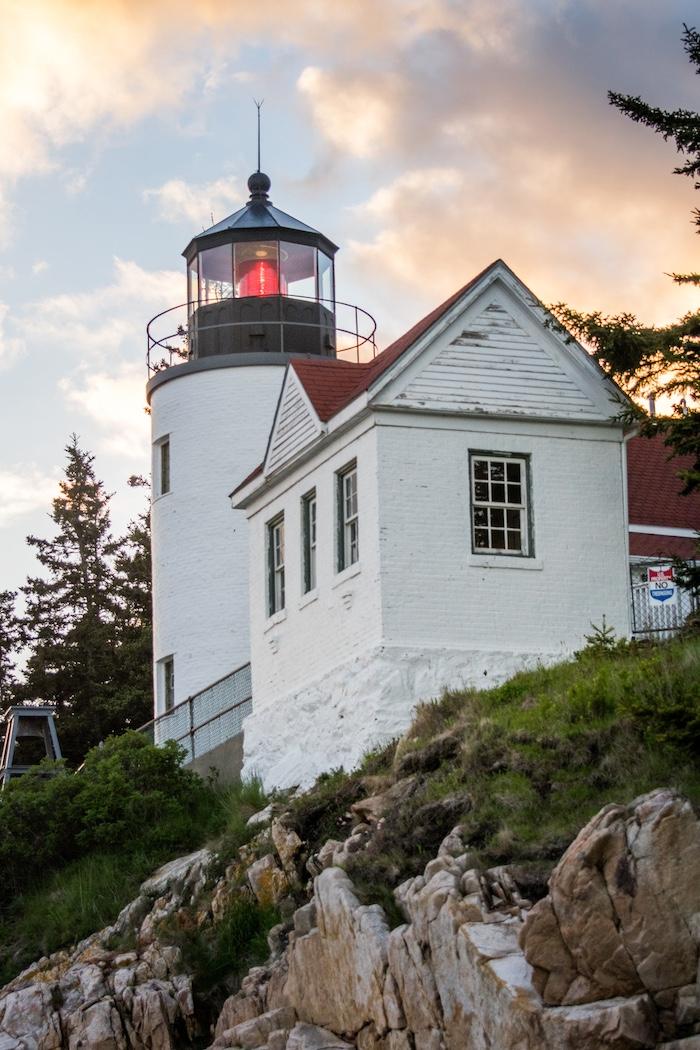
Bass Harbor Light, Acadia National Park/NPS, Kent Miller
Acadia National Park, Maine
Just off the coast of Maine, Acadia has three lighthouses within its borders.
Baker Island Light Station
President John Quincy Adams in 1828 ordered the the lighthouse to be built due to the shallow shoals of the Cranberry Isles, notes the Park Service.
“In 1855, a 13-meter-high white brick lighthouse replaced the original wooden structure, and in 1966, the station’s light was automated,” the agency said. “When the Coast Guard proposed discontinuing use of the lighthouse in 1991 and 1997, local mariners and residents successfully protested, and the lighthouse continues its active duty to the present day.”
Bass Harbor Head Light
The iconic Bass Harbor Head Light Station, which marks the entrance to Bass Harbor and Blue Hill Bay on the southwest corner of Mount Desert Island, dates to 1858 when Congress appropriated funds to build it. The red-hued light that alternates four seconds on and one second off, reaches 13 miles.
Bear Island Light
This lighthouse is on Bear Island, one of five islands that make up the Cranberry Islands. The original lighthouse was built in 1839, rebuilt in 1853 after the original burned down, and decommissioned in the 1980s. Only part of the island is managed by the Park Service; the rest is privately owned, including the land on which the light stands.
Apostle Islands National Lakeshore, Wisconsin
Apostle Islands wins the award for the park with the most lighthouses, or light stations. Some still operate, others have been decommissioned.
Old Michigan Island Lighthouse
This lighthouse has an off and on history. It dates to 1856, when it was built, though it didn’t come online until the next year. But it was abandoned in 1858, only to be relit in 1869. It was retired in 1929. Plan your visit and you can enjoy a guided tour.
Old LaPointe Lighthouse, Long Island
Sadly, only foundation ruins remain of this lighthouse that was built in 1858. While it was “retired” in 1897, it continued to offer housing until 1940.
Raspberry Island Lighthouse
This structure dates to 1862 when it was built (with the light lit in 1863). The lighthouse was enlarged in 1906 and automated in 1947. In 2006 and 2007, the Park Service remodeled the lighthouse and refurnished the keeper’s living quarters as it may have appeared in the early 1920s. Tours are offered.
Outer Island Lighthouse
This lighthouse was built in 1874 on a bluff on the furthest island from the mainland. As the Park Service describes it, the 90-foot-tall light’s design “reflects the Italianate architectural style popular in the 1860s and 70s. Inside the tower, a cast iron staircase spirals up to the ‘watch room,’ where keepers serviced the lamp and kept vigil over the beacon.” The light was automated in 1961. Today it’s beam is powered by the Sun.
Sand Island Lighthouse
Built 1881 from native sandstone, this lighthouse [top photo] is considered by many to be the most beautiful in the lakeshore, if not the entire park system. The light was automated in 1921, moved to a steel tower in the 1930s, then back into the lighthouse in 1985. Still in service today, the Park Service offers guided tours of the facility.
Devils Island Light Tower
This “tower,” the last light station built in the Apostle Islands (in 1891 as a temporary beacon), was moved to a permanent tower in 1898. The facility was automated in 1978 and continues in service these days.
New LaPointe Light Tower, Long Island
This 67-foot cylindrical tower was built in 1897 not far from the original LaPointe Lighthouse. When the “new” light tower built, the original lighthouse was transformed into housing for the keepers. It was abandoned in 1940 and only ruins remain today. The New LaPointe Light continues in operation today.
Chequamegon Point Light Tower, Long Island
This 42-foot tower was built near the western tip of the island in 1897. It was decommissioned in 1987. Though still preserved, the site is not open to the public.
New Michigan Island Light Tower
Crews actually ferried stone from a quarry ten miles from Michigan Island for the lighthouse’s construction in 1856. But it only operated for a year before being shut down in 1858. However, in 1868 its value was seen and it was brought back into service. Years later its location was determined to be poor for helping captains manuever through the islands and a 112-foot skeletal tower found along the Delaware River in Pennsylvania was brought to the island in 1929. It was automated in 1943 and continues in service today. Guided tours are available.
Ashland Harbor Breakwater Lighthouse
Built in 1915 and automated in 1962, this lighthouse continues in service.
Biscayne National Park, Florida
Fowey Rocks Light
This nearly 150-year-old lighthouse is little more than cast-and-wrought-iron topped by a beacon. Construction actually began on the Fowey Rocks Lighthouse in 1875 but it wasn’t completed until 1878 when it was put into operation. According to park officials, it is the second-oldest standing structure in South Florida (excluding the Florida Keys). It was designed and built by the United States Lighthouse Board and managed by that same agency until it was disestablished in favor of the United States Lighthouse Service in 1910. The Lighthouse Service maintained the light until 1939 when it merged with the United States Coast Guard. In 2012 the Coast Guard gave the light to the Park Service.
Cabrillo National Monument, California
This lighthouse overlooking San Diego Bay went into service in November 1855. Unfortunately, it was actually too high — 422 feet above sea level — and would get shrouded in fog and clouds, according to the Park Service. So in 1891 it was decommissioned and another light was built lower and closer to the water. Today the original lighthouse still stands and its interior has been refurbished to how it looked in the 1880s.
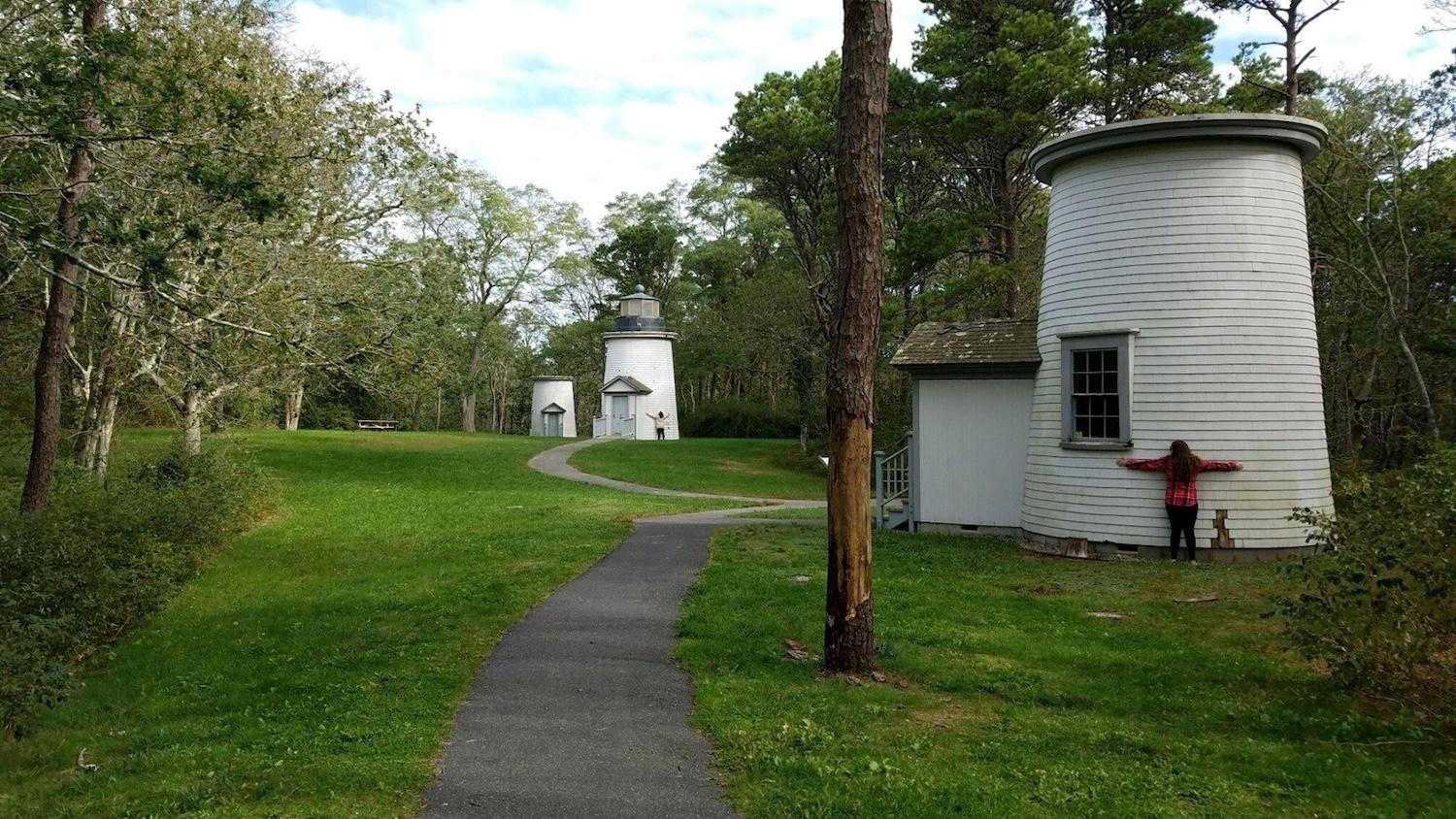
Three Sisters Lights at Cape Cod National Seashore/NPS file
Cape Cod National Seashore, Massachusetts
While there are a number of lighthouses on Cape Cod, most are managed by outside agencies.
The Three Sisters Lighthouses
This trio of lighthouses was built in the 1830s after Congress was petitioned by the Boston Marine Society concerned about shipwrecks and the deaths they caused. The were nicknamed the “three sisters” because from the ocean they looked somewhat like “women in dresses with black hats,” the Park Service notes.
Highland Light Station (Aka Cape Cod Light)
“Commissioned by George Washington and established in 1797 as the 20th light station in the United States, the original 45-foot-tall wooden tower and keeper’s dwelling were built more than 500 feet from the edge of a 125-foot-tall clay cliff,” the Park Service notes. “A new brick lighthouse was erected near the original tower in 1831. The present 66-foot-tall brick light tower, keeper’s house, and generator shed replaced the previous structures in 1857.”
Cape Hatteras National Seashore, North Carolina
Bodie Island Lighthouse
“More vessels are lost there than on any other part of our coast,” was the report Lieutenant Napoleon L. Coste sent Congress after his search along the Outer Banks of North Carolina to find sites suitable for lighthouses. Thus launched the first of three lighthouses that have warned ships away from shoals surrounding this island. The first Bodie Island lighthouse, south of Oregon Inlet, had structural problems with its foundation and had to be replaced after it began tilting. The second light, built nearby, was destroyed during the Civil War by Confederate troops. The third lighthouse, located north of the inlet, went into service in 1872 and continues to this day. During daylight hours, mariners tell the lighthouse by its distinctive pattern of horizontal, alternating black and white stripes. The original lightkeeper’s home, notes the Park Service, is now a ranger station and visitor center.
Cape Hatteras Lighthouse
Built in 1870, the Cape Hatteras Lighthouse protects one of the most hazardous sections of the Atlantic Coast. Offshore of Cape Hatteras, the Gulf Stream collides with the Virginia Drift, a branch of the Labrador Current from Canada, the Park Service says. This current forces southbound ships into a dangerous 12-mile long sandbar called Diamond Shoals. Hundreds and possibly thousands of shipwrecks in this area have given it the reputation as the “Graveyard of the Atlantic.”
In 1999, after years of study and debate over the light being too close to the eroding coastline, the Cape Hatteras Light Station was moved 2,900 feet inland in 23 days and now lies 1,500 feet from the shore — its original distance from the sea.
Access into the lighthouse could be restricted for the next 18 months as crews work to restore and rehabilitate the iconic structure.
Ocracoke Island Lighthouse
Built in 1823, this lighthouse is the oldest operating lighthouse in North Carolina. Ocracoke Inlet was once one of the busiest inlets on the East Coast, and it achieved early notoriety: it was first placed on maps after English explorers wrecked a sailing ship there in 1585, the Park Service notes. “The present lighthouse stands about 75 feet tall and its diameter narrows from 25 feet at the base to 12 feet at its peak. The solid brick walls are 5 feet thick at the bottom tapering to 2 feet at the top, and are crowned by an octagonal lantern,” according to the agency. “Originally an oil-burning light, the Ocracoke Light was electrified in the early decades of the 1900s. Its fourth-order Fresnel lens was installed in 1854 and casts a stationary beam that can be seen 14 miles at sea.”
A Virginia company currently is doing extensive repairs to the lighthouse, to both fix storm damage and raise the Double Keepers’ Quarters and other structures at Ocracoke Light Station to protect them from sea level rise.
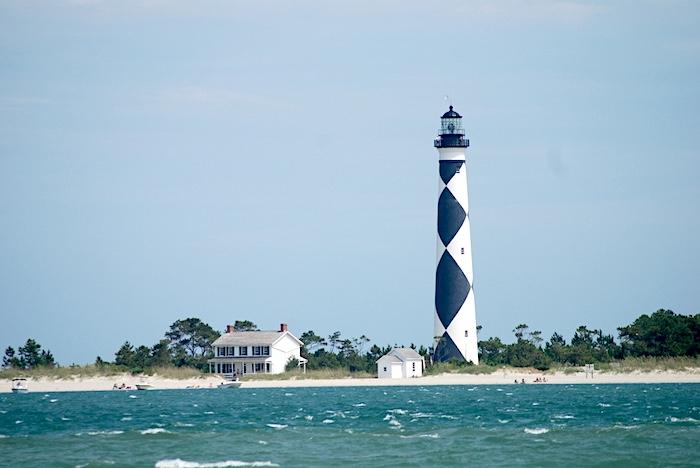
Cape Lookout Lighthouse and Keeper’s Quarters, facing Barden Inlet/Kurt Repanshek file
Cape Lookout National Seashore, North Carolina
Cape Lookout Lighthouse
A lighthouse has warned seafarers off the southern leg of North Carolina’s Outer Banks since 1812. Though the first octagonal light stood 107 feet tall, mariners complained that it wasn’t tall enough and the light too dim. That led to repairs in 1820, but by 1851 the accumulation of needed repairs led to the decision to build a new lighthouse, which went into service in 1859. Confederate soldiers tried, but failed, to destroy the structure.
Channel Islands National Park, California
Anacapa Light Station
Unlike its East Coast peers, this lighthouse on Anacapa Island is comparatively new, having been built in 1932. According to the National Park Service, “An estimated nine-tenths of all vessels trading up and down the Pacific Coast were passing through the Santa Barbara Channel by 1920. Members of the American Association of Masters, Mates and Pilots demanded a fog signal as well as a light. A permanent lighthouse, however, required authorization by Congress. When the tank steamer Liebre grounded on the east end of Anacapa Island on February 28, 1921, directly under the light tower, local inspectors blamed the inadequate station. In 1928, the Bureau of Lighthouses allotted funds for fog signal and radio apparatus for Anacapa, as well as boats and miscellaneous improvements for water supply, sanitation, and grounds improvement. The new lighthouse’s keeper, Frederick Cobb, lit the first light on March 25, 1932. In 1939 the U.S. Coast Guard replaced the Lighthouse Service.”
Dry Tortugas National Park, Florida
Tortugas Harbor Light
The original lighthouse at Dry Tortugas was built in 1824 on what later became the parade ground for Fort Jefferson, a Civil War-era masonry fort. Fifty-four years later the Garden Key lighthouse was built, but it was deemed insufficient and a taller lighthouse on nearby Loggerhead Key was built.
The Garden Key light, meanwhile, suffered hurricane damage in 1873 and again in 1875. In 1876, a lighthouse made out of iron replaced the Garden Key light. “Harsh marine conditions of Dry Tortugas have affected the structural integrity of the [Tortugas Harbor Light]. General maintenance and repairs were completed in 1930s, 1970s, 1990s, and 2000s.”
Fire Island National Seashore, New York
Fire Island Light
The first lighthouse built on the western end of Fire Island rose in 1826, standing 74 feet tall. It was replaced in 1858 with the lighthouse you see today.
Fort Monroe National Monument, Virginia
Old Point Comfort Light
While anecdotal stories tell of both Native Americans and later a Virginian setting fires on a peninsula known as Point Comfort to guide ships to Hampton Roads, it was in 1802 that a 54-foot-tall lighthouse was built there. “A spiral staircase leads to the top, where ten oil lanterns burned 486 gallons of oil per year (today the oil lanterns are replaced by modern bulbs),” the Park Service says.
Fort Point National Historic Site, California
Fort Point Lighthouse
“The original light was built and destroyed in 1853. Army engineers blew up the bluff it stood on to make way for the construction of Fort Point,” according to the Park Service. “A second lighthouse, built near the water in 1855, was removed to permit seawall construction. In the end, it was the third lighthouse, designed by Brevet Lieutenant Colonel Robert S. Williamson, that did the trick. Construction was completed on top of the fort in 1864. This final installment can still be seen today. Rated as a fifth order Fresnel light, it could be seen 10-12 miles at sea.”
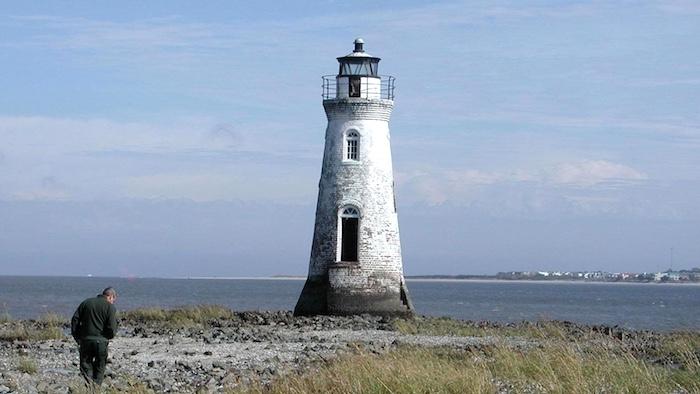
Cockspur Island Light, Fort Pulaski National Monument/NPS file
Fort Pulaski National Monument, Georgia
Cockspur Island Light
Historical records cited by the Park Service indicate that the first “brick tower, used as a daymark, was built on Cockspur Island between March 1837 and November 1839. In 1848, John Norris, a New York architect, was contracted to supervise construction of an illuminated station.” That first lighthouse rose just 25 feet above sea level, with a beam generated by five lamps. While a hurricane destroyed the structure in 1854, it was rebuilt and managed to survive the Civil War with minimal damage.
“The Cockspur Lighthouse was decommissioned on June 1, 1909, due to low usage of the South Channel for navigation,” according to Park Service records. “As the threat to the beacon by salvage crews and other private interests grew, the National Park Service looked into the acquisition of the light. On August 14, 1958, by presidential proclamation, the Cockspur Lighthouse was transferred from the United States Coast Guard to the National Park Service. The National Park Service is dedicated to the preservation of this historic marker.”
The light is closed to the public.
Fort Sumter National Memorial, South Carolina
Charleston Light
According to the Park Service, “[I]n 1767 a permanent lighthouse was built on the south end of Morris Island at the main entrance to the ship channel. Confederate forces destroyed the lighthouse in 1861 to conceal the harbor entrance from U.S. forces. After the Civil War a new lighthouse was built on Morris Island in 1876. The construction of jetties to redirect the ship channel caused significant erosion on Morris Island. Today, the 158-foot tall Morris Island Light sits 1700 feet out to sea.”
The Charleston Light was built on Sullivan’s Island in 1962. “Not a typical circular shape, the lighthouse is triangular, with steel girders for the framework and aluminum alloy for siding. The unusual design was chosen for of its ability to withstand winds up to 125 miles per hour,” the Park Service notes.

Point Bonita Lighthouse, Golden Gate National Recreation Area/Kurt Repanshek file
Golden Gate National Recreation Area, California
Alcatraz Island Light
Rising above its more famous prison on Alcatraz Island, the lighthouse became the first lighthouse on the West Coast when it was built in 1854. “The cottage-style lighthouse building was replaced by the taller 95-foot structure in 1909 because it was no longer tall enough to shine over the new cellhouse,” the Park Service says. “In 1963, when the penitentiary closed, the lighthouse became automated and a modern beacon was added.”
Point Bonita
Construction of this light station began in 1899. To reach the lighthouse, you need to walk through a tunnel carved through basalt. Why it was done, history doesn’t say, according to the Park Service.
Kalaupapa National Historical Park, Hawai’i
Molokai Light
Light beamed out of this lighthouse beginning in September 1909 from a Fresnel lens “rare and huge crystal-like glass lens that spun on a bath of mercury,” the Park Service says.
“It was the brightest light in the Pacific and flashed twenty-one miles to sea. To the settlement’s [Hansen’s disease] patients, just two miles away, the light rhythmically sweeping over the pali (cliffs) was a part of their lives. Former patient Richard Marks once commented, ‘They talk about the statue of liberty, well, this light was the first thing that hundreds of thousands of immigrants to Hawai‘i saw when they came here… That light has been very special to the people here…. It has been here longer than any living person has. You could always look out and see it sweeping across the cliff… It is the Kalaupapa Light.’”
Isle Royale National Park, Michigan
Isle Royale Lighthouse
This lighthouse, built in 1875 and automated in 1913, “features a 61-foot double-walled octagonal sandstone tower, with a black lantern and gallery,” the Park Service says.
Passage Island Lighthouse
Built in 1882, “the lighthouse originally used a Fourth Order oil-burning wick lamp and appeared as a fixed red light; later, it was modified to a flashing white light,” the agency said. It was deemed the most important of Isle Royale’s lighthouses because it marked way between Blake Point and Passage Island.
Rock Of Ages Light
Just outside Washington Harbor, this lighthouse came to life in 1908. “The 117-foot white cylinder-shaped lighthouse is composed of steel, concrete, and brick, with a black base and lantern. … Today, the unmanned lighthouse features a 300 millimeter Tideland Signal Acrylic Optic lens that runs on solar power.”
Rock Harbor Light
This lighthouse, built in 1855, no longer operates, but does attract a lot of camera-bearing visitors. “In 1859, as copper mining declined, the Rock Harbor Light was shut down, but the light was rekindled in 1874 when copper mining resurged. In 1879, it was permanently closed, but remains a popular tour stop for visitors today,” notes the Park Service.
Pictured Rocks National Lakeshire, Michigan
Au Sable Light Station
Built in 1873-1874, the light tower rises 86 feet … and “extends 23 feet underground and is anchored in bedrock,” according to the Park Service.
“The lighthouse became fully automated in 1958 and transferred from the Coast Guard to the National Park Service in 1968. The lighthouse still operates – a smaller, solar-powered light now sits on the catwalk railing and shines over Lake Superior every evening,” the agency adds.
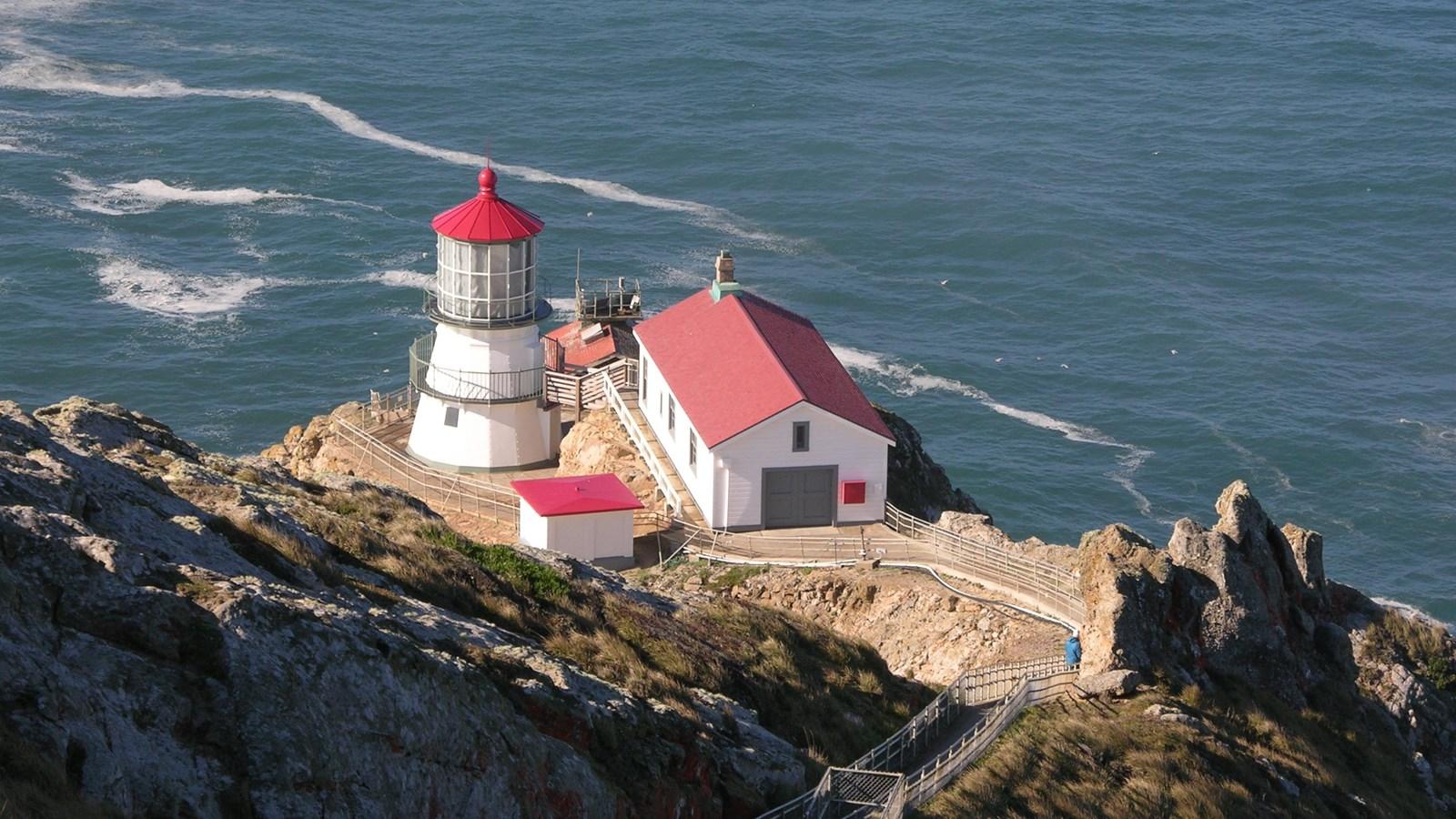
Point Reyes Lighthouse, Point Reyes National Seashore/NPS file
Point Reyes National Seashore, California
Point Reyes Lighthouse
“To help mariners navigate the tricky Point Reyes Headlands, the U.S. Lighthouse Service built this lighthouse in 1870 in Inverness, California. At sundown, the lightkeeper would light the oil lamp inside the first-order Fresnal lens, which would then be rotated by a brass clockwork mechanism, sending a beam of more than 1,000 prisms out to the sea,” the Park Service notes. “The Point Reyes Lighthouse was retired from service in 1975 when the U.S. Coast Guard installed an automated light adjacent and below the historic tower.”
Sleeping Bear Dunes National Lakeshore, Michigan
South Manitou Island Light
This 100-foot-tall lighthouse was active from 1871 to 1958. It stood over a protected harbor where ships would seek shelter from storms. Steamships also would stop there to restock wood for their boiler fires.
Traveler postscript: An equally fascinating history lies in the U.S. Lifesaving Service, which was the precursor to today’s U.S. Coast Guard and establishing stations in many coastal area. You can learn about it in this story from Traveler’s archives.





